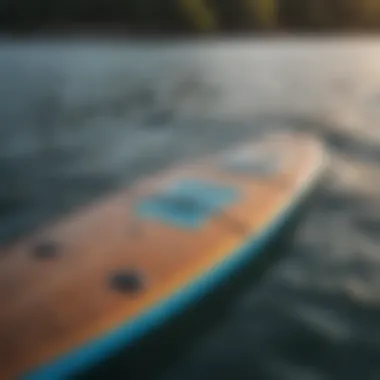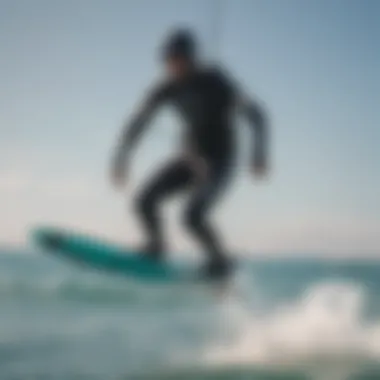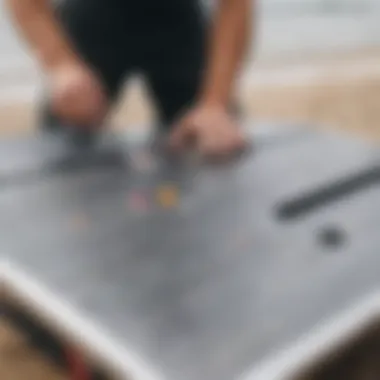Comprehensive Guide to Understanding Foil Boards


Intro
Foil boards have been catching the eye of kiteboarding enthusiasts everywhere, becoming a vital tool in mastering the winds and waves. They don't just allow adrenaline junkies to ride the surf but also open up a world of sensations that traditional boards can’t quite replicate. Understanding their nuances and the precise mechanics behind their design empowers riders to push their limits. This guide isn’t merely a how-to; it’s an exploration of the subtleties that make foil boarding so unique.
As we dive deeper, we'll unravel the science behind these boards and unravel how personal preferences intertwine with skill levels and conditions on the water. From understanding gear selection to navigating skill development, this comprehensive guide aims to equip both novices and seasoned kiteboarders with the knowledge they need.
Gear Selection
When it comes to gear selection, some factors truly help to set the stage for a rewarding experience on the water. Selecting the right equipment involves understanding not just what’s available on the market but also what fits your individual style and performance goals.
Types of Kites
A kite is not just a means to propel you across the water; it’s the very heart of your kiteboarding adventure. They come in different shapes, sizes, and designs, catering to diverse riding conditions and styles. Here are a few common types:
- Foil Kites: These are lighter and more efficient, allowing smoother flights in less wind. They have a unique structure that gives them an advantage in high-performance scenarios.
- Leisure Kites: Ideal for beginners, they offer more stability and are designed for casual riding.
- Wakestyle Kites: If amplitude and learning tricks is your cup of tea, these are the kites for you. They tend to provide more power and hang time.
For newcomers, it's best to opt for a more forgiving kite that allows for gradual learning curves. Getting comfortable with your equipment can make a world of difference as you progress.
Choosing the Right Board
When selecting a foil board, factors like size, shape, and materials play critical roles in performance. Here are insights to ponder:
- Size: A larger board offers stability and floatation, which is particularly helpful for beginners, while a smaller board allows for quick movements and agility.
- Shape: Boards vary from having a wider nose for better upwind capabilities to narrower tails for speed. Understanding your riding style will guide your choice.
- Material: Lightweight materials like carbon offer responsiveness, but they often come at a higher price point. In contrast, foam boards tend to be more forgiving, catering well to leisurely rides.
Once again, it’s essential to align your choice with your skills and aspirations.
Skill Development
Knowing how to maneuver on your board is just as important as having the right gear. Developing essential techniques will not only enhance performance but also instill confidence, making every ride more enjoyable.
Essential Techniques
Learning to foil can be daunting, but breaking it down into specific techniques can demystify the process. Here are some fundamental skills to master:
- Body Positioning: Keeping your weight centered over the board is crucial for balance.
- Edge Control: Practicing edge control will help prevent unnecessary falls while aiding in transitions.
- Turns and Transitions: Developing smooth transitions can greatly enhance your ride.
Progression Tips
To genuinely elevate your skills, implementing a structured approach is beneficial. Here are a few steps that often guide personal advancement:
- Set Realistic Goals: Start with achievable targets rather than leaping into more complex maneuvers too quickly.
- Practice Regularly: Consistency is key. Try to get on the water regularly to hone your skills.
- Learn from Others: Engaging with the kiteboarding community can provide extra insights that you might not find in books or videos.
Practice makes Progress
Every ride is a building block to your skill set. Landing tricks and smooth transitions require repetition—but with each session, you'll find you're able to challenge yourself with increasing complexity.
In summary, this guide unpacks the essence of foil boards from gear selection to skill development. As the kites catch the wind, let your skills catch up with your equipment, propelling you towards an exhilarating future in kiteboarding.
Preface to Foil Boards
Foil boards have become increasingly popular among kiteboarders seeking to elevate their experience on the water. They combine the thrill of surfing with the exhilarating lift that only a hydrofoil can provide. This section aims to familiarize both novices and experts with the essential aspects of foil boards, underscoring their significance in the world of kiteboarding.
As we dive deeper into the intricacies of foil boards, it's vital to understand how they work and the unique advantages they offer. At its core, a foil board lifts the rider above the water’s surface using a specially designed hydrofoil submerged beneath the board. This innovative design not only minimizes drag but also grants the rider the ability to glide smoothly over the waves, even in relatively low wind conditions.
What is a Foil Board?
A foil board is a specialized type of board that features a foil attachment underneath. The foil itself consists of a mast and wings, and this assembly generates lift when the board moves forward. Achieving this lift allows the rider to float above the water, resulting in a sensation akin to flying. This basic principle underpins many of the exciting aspects of foil boarding—its unparalleled speed and freedom on the water.
To put it more vividly, think of the sensation of refining your balance while gliding above the shimmering surface of the ocean. It’s an experience that melds the thrill of a high-speed ride with the grace of soaring through the air, making cold ocean water seem like a tranquil lake.
Besides providing a unique riding experience, foil boards also open up a new world of potential activities. Whether you're looking to perform tricks, race at high speeds, or simply enjoy the waves in a new light, there’s something for everyone to explore with this type of gear. Isn’t it exciting to consider the possibilities of a sport that rewards creativity and skill at every level?
The Evolution of Foil Boards
The journey of foil boards dates back several decades, with origins rooted in experimental watercraft design. Initially, they were crafted for niche markets and were primarily used by innovators who sought out new ways to ride on water. However, as technology advanced, so did the designs and materials employed in creating foil boards.
Today’s foil boards are the product of rigorous testing and design optimization. They've evolved from heavy, cumbersome models to lightweight, aerodynamic versions that are not only more accessible but also far more efficient. The advent of materials like carbon fiber has allowed manufacturers to produce boards that are both strong and incredibly light, enhancing performance significantly.
In essence, you could say the evolution of foil boards mirrors the progression of technology in many sports—where every innovation leads to new styles, techniques, and experiences on the water. This constant evolution keeps the sport fresh, ensuring that even seasoned kiteboarders continually discover new facets of foiling.
As we venture through this guide, remember that understanding these foundational elements is crucial, not only for making informed purchases but also for maximizing the enjoyment and performance of your foil boarding experience.
Types of Foil Boards
Understanding the various types of foil boards is crucial for any kiteboarder looking to enhance their experience on the water. Each type of foil board is designed to accommodate different riding styles and conditions, making it essential for enthusiasts to select the right one. Whether it’s freeriding, racing, or surfing, each category brings its unique elements into play, enabling riders to capitalize on their strengths and preferences. Ultimately, grasping these differences aids in making an informed purchasing decision, ensuring that the board aligns with one’s particular foiling ambitions.


Freeride Foil Boards
Freeride foil boards are marked by their versatility. These boards are often wider and more stable, accommodating riders looking to cruise across flat waters or tackle small waves with ease. The generous volume in these boards contributes to excellent buoyancy, making them ideal for beginners and those transitioning from traditional kiteboarding to foiling.
When selecting a freeride foil board, consider the following:
- Board size: Generally, a larger board enhances stability, while a smaller board offers speed.
- Construction materials: Boards made from durable foam or composite materials tend to last longer.
- Foil compatibility: Some freeride boards come with integrated foil mounts, which makes it easier to switch foils based on conditions.
These boards are perfect for those just starting out, giving them a soft landing as they learn the ropes of foiling. With freeride foil boards, the emphasis is on cruising and enjoying the ride.
Race Foil Boards
For those who thrive on competition, race foil boards are the go-to choice. They are designed for speed and efficiency, enabling riders to slice through water with minimal drag. Typically longer and narrower than their freeride counterparts, these boards demand a higher level of skill due to their less forgiving nature.
Considerations when looking at race foil boards include:
- Aspect ratio: Higher aspect ratios help in achieving greater speeds but require better balance and technique.
- Weight: A lighter board can enhance performance, but sturdiness is also important for handling rough conditions.
- Hydrodynamics: Shaping and design play a significant role in how the board interacts with water.
Competitive kiteboarders often seek these boards for their sophisticated craftsmanship and performance capabilities. They are built for those who aim to push boundaries and chase the finish line.
Surf Foil Boards
Surf foil boards bridge the gap between kiteboarding and surfing. These boards are generally shorter with a more compact design, allowing for quick maneuverability and responsiveness. Ideal for surf conditions, they enable riders to catch waves and glide effortlessly over the surface.
Important factors to take into account when selecting surf foil boards include:
- Tail shape: Different tail shapes affect the performance in terms of carving and maneuvering.
- Volume distribution: Boards with a balanced volume distribution offer enhanced buoyancy and stability when catching waves.
- Fin setup: A customizable fin setup can significantly influence how the board performs in various surf conditions.
Riders who opt for surf foil boards are seeking a unique thrill that combines both sports, granting them the ability to transition seamlessly from boarding to surfing. These boards cater to those who appreciate the nuances of wave riding.
"Choosing the right type of foil board is like picking the perfect tool for a job; it can make all the difference in your performance and enjoyment on the water."
Key Features to Consider When Buying a Foil Board
Selecting the right foil board is akin to choosing the perfect playbook in a high-stakes game. It’s essential not just to know what looks good, but to understand the intricacies that contribute to your overall performance on the water. A well-informed decision can elevate your kiteboarding experience to new heights, ensuring that you maximize both fun and efficiency.
When diving into foil board selection, keep your eyes peeled for key features that can significantly influence how you glide across the waves.
Board Size and Volume
In the world of foil boards, size does matter—though not in the way you might expect. The board's dimensions, particularly its length and width, play a pivotal role in stability and maneuverability. A larger board often offers increased stability, making it a solid choice for beginners. The added volume can help with early take-off and support the rider as they learn the ropes.
Conversely, a smaller board might be the best bet for experienced riders looking to carve sharp turns and increase speed. This size aids in more aggressive maneuvers but can sacrifice some stability.
- Beginner Riders: Opt for a board that provides more volume—think wider and longer boards.
- Advanced Riders: Smaller, narrower boards might suit your fast-paced style better.
Deciding on the right size is about balancing your personal preference with your skill level and the conditions you expect to face. The goal is to match your board size with your kiteboarding ambitions.
Foil Design and Construction
The nuts and bolts of foiling lie in the design and construction of the foil itself. From materials to shape, there’s much to unpack. Most foils are crafted from lightweight yet strong materials, with carbon fiber being a popular choice for more advanced models due to its optimal stiffness-to-weight ratio.
The shape of the foil wings also has a profound impact on your riding experience. Wider wings can provide better lift at lower speeds, making them ideal for novices trying to get air under their feet. On the flip side, thinner wings may allow for faster ride and help against drag.
Some considerations include:
- Wing Shape: Ensure it suits your style; larger wings for stability, smaller for speed.
- Material: Choose a construction that balances durability with weight.
A well-designed foil can enhance lift and control, making your time on the water much more enjoyable.
Weight Distribution and Balance
Imagine walking a tightrope: the slightest misstep can throw everything off balance. The same principle applies to a foil board. Weight distribution is critical for both stability and performance, directly affecting how the board rides at different speeds and conditions.
Many boards feature specific placement of the foil to optimize performance. A common recommendation for most riders is to place the foil forward on the board, as this can help maintain a balanced ride. The board's construction should also support the overall weight without compromising on agility.
To enhance your understanding, think about it like this:
- Front-Heavy Setup: This usually offers better lift but may hinder quick turns.
- Back-Heavy Setup: This allows for sharp turns and tricks, ideal for those who want to push their limits.
Ultimately, achieving a balanced setup is key—not just to the ride, but to keep you safe while you're out enjoying the elements.
"Choosing the right board is like finding the perfect partner; it requires understanding, compatibility, and a bit of trial and error."
By focusing on these essential features—board size and volume, foil design and construction, as well as weight distribution and balance—you’re on track to make an informed decision that aligns perfectly with your riding goals. Taking the time to assess these factors not only contributes to better performance but also elevates your kiteboarding experience as a whole.


Where to Buy Foil Boards
Finding the right place to purchase a foil board is a vital step in ensuring your entry or advancement in the sport of kiteboarding is both enjoyable and productive. Selecting the right board can tremendously influence your overall experience on the water. Each buying option has its crafts and quirks, allowing you to weigh the pros and cons based on your personal needs and budget constraints. First, let’s explore the local retailers and shops.
Local Retailers and Shops
Purchasing from local retailers or shops can provide significant benefits. For starters, you get the chance to physically inspect the foil board before making a decision. You will look at the craftsmanship, feel the weight, and get a first-hand grip of its size. Plus, many retailers arrange demo days or opportunities for customers to test boards in real water conditions, which is absolutely invaluable.
Look for shops that have experienced personnel, as they can offer insights tailored to your specific skill level. This service can include recommendations, answers to any nagging questions, and tips based on local conditions.
Moreover, buying locally often shortens the wait time; you don’t have to worry about shipping delays or damaged products that sometimes befall online orders.
Additionally, there's the aspect of supporting your local economy. It fosters community ties and ensures the future of your favorite shops. After all, they play a key role in local kiteboarding culture.
Online Marketplaces
When convenience is your main objective, online marketplaces can be hard to beat. Platforms like Amazon and eBay offer an expansive range of foil boards that you might not find in local shops. With just a few clicks, you can compare brands, prices, and features in one place.
Keep in mind, however, that shopping online often comes with its own set of challenges. Since you're not physically present, inspecting the quality of the board becomes nearly impossible. You have to rely heavily on customer reviews and product descriptions.
Additionally, shipping costs can add up, and returns may not be as straightforward. It's crucial to check the return policy of the marketplace or dealer to avoid getting stuck with a board that doesn’t meet your needs.
While online shopping can be much more relaxing and time-saving, make sure you do your homework to ensure you're buying from reputable sellers and platforms.
Second-Hand Options
The second-hand market can be a treasure trove for the savvy shopper. You can often find high-quality, lightly used foil boards at a fraction of the retail price. This can be particularly advantageous for newcomers to the sport who might not want to invest heavily right away.
Websites like Craigslist, Facebook Marketplace, or even kiteboarding-specific forums can provide ample options. Just keep some best practices in mind: always arrange to meet in a public place for exchanges, and inspect the board carefully. Look for any signs of damage such as cracks or signs of corrosion, particularly on the foil.
Another important point is to ask the seller about the board's history, such as prior repairs or usage. This information could save you headaches down the line.
"Used gear can be just as good, if you know what to check for. It's all about doing a little digging and asking the right questions."
In sum, the right place to buy a foil board plays a crucial role in your foiling journey. Whether you lean towards the personalized shopping experience of local shops, the expansive world of online marketplaces, or the budget-friendly second-hand options, each avenue offers its own unique benefits and considerations. Take your time to explore each option, ensuring you make an informed decision that aligns with your personal preferences and needs.
Budget Considerations
When diving into the world of foil boarding, it's crucial to keep a keen eye on your budget. This is not merely about slapping down some cash for a new toy; it’s about making a thoughtful investment that aligns with your skill level and enthusiasm. Understanding where to allocate your funds can make or break your experience on the water.
Almost every aspect of foil boarding—from the board itself to the necessary gear—comes wrapped in varying price tags. So, it’s not just about finding one that looks good on your first perusal, but rather weighing the long-term benefits and performance that can come from a more considered choice. This careful calculating of costs ensures that enthusiasts can find equipment that will last through the seasons, rather than opting for the first thing that catches their eye.
Understanding Pricing
Understanding the pricing structure of foil boards is vital for newcomers and seasoned riders alike. Prices can swing like a pendulum, influenced by multiple factors including brand reputation, materials used, and intricate design features. Some boards, particularly those designed for high-performance racing or advanced techniques, can tip the scales into the thousands, while recreational options might sit comfortably in a lower range.
- Brand Reputation: Well-established brands may charge a premium, but their products often come with assurances of quality and durability.
- Material Composition: Boards made of advanced composites will likely carry a higher price than those built from standard materials, but they often offer better performance in terms of weight and strength.
- Design Complexity: Boards that incorporate innovative designs or technology, like adjustable foil systems, can also add to the cost.
It's worth exploring what your local shops or online marketplaces showcase. You might stumble upon seasonal sales or promotions, which could beef up your purchasing power. Compare prices across various platforms, as sometimes online retailers offer significant markdowns compared to physical stores. This ensures that your hard-earned cash isn’t landing in someone else's pockets unnecessarily.
Cost vs. Performance Analysis
Now, let’s break down the age-old debate: cost versus performance. This isn’t just adding the sums and hoping for the best, but looking at each option’s value proposition.
When pondering a purchase, consider:
- Skill Level: If you’re in the starting phases, a less expensive board might serve well enough while you’re mastering the basics. On the other hand, if you’ve honed your skills and are looking for that competitive edge, splurging on a high-performance board makes more sense.
- Intended Use: Know what kind of riding you plan on doing. Boards for racing require a different set of features than those made for leisurely surfing in gentle waves. Redirecting your spending based on this can amplify both safety and enjoyment.
- Long-Term Investment: Sometimes the upfront cost can seem steep, but a well-built board that stands the test of time can save you money in the long run. It all boils down to performing your own ROI analysis (return on investment), considering how often you plan to ride, where you’ll use it, and whether you anticipate replacing gear frequently.
*"A penny saved is a penny earned," but it might be wiser to study the value earned from each penny spent."
In summary, managing your budget while considering the vast array of options out there is a balancing act that deserves your full attention. By properly assessing pricing structures and aligning your purchases with your unique needs and aspirations in kiteboarding, you'll not only get the right gear but also enjoy the thrill of the ride without the worry of regrets.
Maintenance and Care for Foil Boards
Taking good care of your foil board isn’t just about keeping it looking sharp; it’s about ensuring its performance and longevity on the water as well. Like any high-performance equipment, foil boards need a touch of tender loving care. By following some straightforward maintenance and care principles, you can avoid costly repairs or replacements down the line, making your time on the water much more enjoyable.
Cleaning and Storage Tips
Keeping your foil board clean is a must if you want to maximize its lifespan. Here are some practices that can make a significant difference:
- Rinse After Every Use: After hitting the waves, give your board a good rinse with fresh water. Saltwater and sand can be cruel and cause corrosion over time.
- Use Non-Abrasive Cleaners: When cleaning, steer clear of harsh chemicals or abrasive materials. A mild soap with a soft sponge will do the job without risking any damage.
- Dry Completely Before Storage: Moisture can lead to mold or mildew, which can ruin both the board and your riding experience. Make sure to dry your board completely, especially in tight spaces.
- Proper Storage Location: Store it away from direct sunlight and extreme temperatures. A cool, dry place — away from heavy machinery or other equipment — is ideal.
Following these tips helps maintain both the aesthetics and the integrity of your foil board, keeping it ready for whatever adventures await.


Equipment Check Before Use
Conducting regular equipment checks is as important as the care you give your board. Here’s a step-by-step process to ensure everything is in tip-top shape before you head out:
- Inspect the Board for Damage: Look over your board for cracks, dings, or signs of wear. Pay attention to the edges; they can take a beating and often need some extra love.
- Check the Foil: Ensure that the foil is securely attached and there are no signs of wear like dents or bends. A compromised foil can throw off your balance, making it harder to control your board.
- Review Your Leash and Fins: These components are crucial for safety and control. Ensure the leash isn’t frayed and that the fins are secure and undamaged.
- Gear Up with Other Essentials: Don’t forget your personal safety gear. A proper helmet and impact vest can make a big difference in case of a fall.
"Regular maintenance not only saves you money but also ensures a safer, more enjoyable experience on the water."
Taking these proactive steps reinforces a culture of safety and responsibility in the sport. Building a habit of checking your equipment directly contributes to a successful, fun day out on the waves.
With proper care and maintenance, your foil board will serve you well for many adventures to come. Remember, a little effort today can translate to countless exhilarating rides tomorrow.
Safety Protocols and Tips
Safety protocols play a critical role in the world of foil boarding. Engaging in this exhilarating sport inherently carries some risks, and understanding how to mitigate these risks is paramount to an enjoyable experience. Emphasizing safety doesn't take away from the thrill; in fact, it enhances it by allowing riders to focus on mastering their skills without unnecessary fears. Let's explore the essentials of safety protocols when it comes to foil boarding, along with insights on indispensable gear and the importance of weather awareness.
Essential Gear and Equipment
The right gear is the backbone of any safe and enjoyable boarding experience. Here’s a rundown of critical items all kiteboarders, especially those who enjoy foiling, should prioritize:
- Impact Vest: A good quality impact vest offers not just buoyancy but also adds a layer of cushioning against falls. It’s like wearing an insurance policy—cushioned, yet flexible.
- Helmet: Protect your noggin. A helmet designed for water sports provides head protection that can be vital in high impact situations. Dings and bumps are part of the deal, but a helmet makes sure they don’t become serious injuries.
- Leash: This piece of gear is often overlooked but can be a lifesaver. An effective leash keeps your board close, preventing loss of control and injury to others in the water—it's a simple but important tether.
- Footwear: While some riders prefer the freedom of going barefoot, water shoes or booties with a good grip can be beneficial for maintaining traction, especially in rocky or slippery conditions.
Tip: Check all gear before heading out, ensuring everything is in good condition. A loose strap on a helmet can quickly defeat its purpose.
Understanding Weather Conditions
Weather can make or break your foiling adventure. Understanding the implications of changing weather patterns is key to staying safe on the water. Here are some points to keep in mind:
- Wind Conditions: Foil boarding thrives on wind, but not all wind is good wind. Check for consistent wind speed and direction. Sudden gusts can catch even the most seasoned riders off guard. Generally, steady winds of 12 to 20 knots are ideal, but this can vary based on an individual's skill level.
- Storm Awareness: Pay attention to storm forecasts, and respect the power of nature. "Better safe than sorry" is a saying that rings true in water sports. Lightning and torrential rains can come up quickly, so be ready to head back at the first sign of trouble.
- Water Conditions: Waves and tides can change in the blink of an eye. Look to avoid areas with strong currents or waves that can make launching and landing challenging. Staying aware of local tide charts can help you choose the right spots.
"Keeping an eye on the sky is as crucial as keeping an eye on your board."
- Temperature Changes: Understand how temperature can affect your performance. Colder conditions may require thicker wetsuits, while too much sun can lead to heat exhaustion. Always be ready for temperature fluctuations.
By investing time to prepare with the right gear and understanding weather conditions, kiteboarders can significantly reduce their risks on the water. These protocols not only enhance safety but also create a framework for a more pleasurable and confident foiling experience.
Environmental Considerations
When it comes to engaging with the ocean's vast expanse, understanding environmental considerations cannot be overstated. Kiteboarding, including the use of foil boards, has grown in popularity. But with this growth comes the responsibility to be mindful of our precious marine ecosystems. The choices we make while enjoying this sport can have lasting impacts on the environment, and it's crucial for every kiteboarder—be it a beginner, instructor, or enthusiast—to integrate sustainable practices into their routines.
Sustainable Practices in Kiteboarding
Adopting sustainable practices in kiteboarding is not just a trend; it's a necessity. Here are some key points that kiteboarders can keep in mind to reduce their ecological footprint:
- Choose Eco-Friendly Equipment: Opt for foil boards and kites that are made from sustainable materials. Brands that prioritize environmental responsibility often utilize recycled or biodegradable materials in their products.
- Limit Your Impact on Natural Habitats: Respect sensitive areas such as nesting sites for birds or breeding grounds for marine life. These areas should be avoided, especially during sensitive seasons.
- Follow the "Leave No Trace" Principle: Always clean up after yourself. Carry out any trash, including broken equipment parts, to ensure that you’re leaving the environment as pristine as you found it.
- Educate Yourself on Local Wildlife: Understanding the local flora and fauna can foster a deeper appreciation and encourage kiteboarders to behave responsibly while on the water.
"Sustainable practices go a long way. Not only do they protect our oceans, but they also enhance our experience on the water, providing untouched landscapes to enjoy for years to come."
Impact of Foil Boards on Marine Life
Foil boards themselves can have a subtle yet significant effect on marine ecosystems. While these boards are generally more efficient in terms of gliding on the water, concerns remain about their interaction with marine life. Here are some considerations worth pondering:
- Noise Pollution: The sound generated by the movement of foil boards can disrupt the natural behavior of fish and other marine creatures. Some species rely on sound for communication, mating, and navigation.
- Physical Displacement: As foil boards glide above the water surface, they can unintentionally disturb marine life. Fish may flee from their usual habitats, which can lead to a disruption in local biodiversity.
- Erosion of Shorelines: Frequent use of certain areas can lead to erosion, impacting habitats for various species that rely on stable shorelines for nesting or feeding.
In summary, the allure of foil boarding should not overshadow the need for responsible practices. By being conscious of how our activities affect marine ecosystems, we can ensure that future generations of kiteboarders can also enjoy the beauty of nature without contributing to its decline.
End and Final Thoughts on Purchasing a Foil Board
As we draw the curtain on our exploration of foil boards, it’s important to reflect on the key themes we've navigated. Understanding and acquiring a foil board goes beyond simply picking one because it looks cool. It involves an intricate dance of choice, knowledge, and adaptation. This section serves as a sort of roadmap that ties together the various strands we've discussed throughout the article, reinforcing why making an informed decision is vital.
Investing in a foil board should be viewed as a step toward a more exhilarating kiteboarding experience. The right board can significantly enhance performance, provide greater control, and allow for fun and fluid movement over the water. By considering factors such as board size, weight distribution, and your own skill level, you can tune your selection process to meet your personal needs, making sure that your foil board is not just a piece of equipment, but an extension of your riding style.
Moreover, safety should always be at the forefront of your mind. Understanding weather conditions and acquiring essential gear can transform a good day into a great day by minimizing risks. Remember that every session out on the water carries an element of unpredictability. Adopting the right precautions can safeguard your experience.
Lastly, as we face environmental challenges, it is crucial to be mindful of our choices in gear and practices related to kiteboarding. Opting for sustainable materials or practices can not only help preserve marine life but also ensure that we can enjoy our beloved sport for years to come. This dual awareness of performance and environmental impact adds another layer of satisfaction to your riding experience.
"A good surf session is not about how many waves you ride, but how well you connect with the environment while doing it."
Summarizing Key Insights
To recap the journey we’ve embarked upon, here are the high points to take back home:
- Types of Foil Boards: There’s a broad spectrum of foil boards available, each with their unique strengths tailored to different riding styles, be it freeride, race, or surf foil boards. Exploring these options lets you select what aligns best with your goals.
- Buying Considerations: Factors such as board size, volume, and foil design will determine your performance. Weigh these elements carefully against your skill level and riding intentions to find your perfect match.
- Importance of Safety: Being prepared means more than just gearing up. It involves understanding the environment to make informed decisions that ensure safety on the water.
- Environmental Impact: As kiteboarders, we must remain vigilant stewards of the ecosystems we enjoy. Making environmentally conscious choices can extend the beauty and accessibility of these places for future generations.
Future of Foil Boarding
Foil boarding is on the cusp of becoming more prominent, with technological advancements continually pushing the envelope. Innovations in material technology can lead to lighter, stronger boards that improve performance. As companies experiment with different shapes and designs, riders can expect boards that respond better to varying conditions, offering an increasingly specialized experience.
Moreover, community engagement through social media platforms like reddit.com and facebook.com fosters shared experiences and knowledge exchange that can further enrich skill development and safety practices. As more kiteboarders take to the waters, our collective understanding of foil boarding will deepen, creating a vibrant community.
In essence, the future of foil boarding is bright and full of promise. As riders, instructors, and event organizers, we will help shape that future by embracing innovation while respecting the values that have brought us together in this exhilarating sport.















